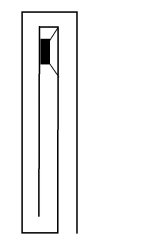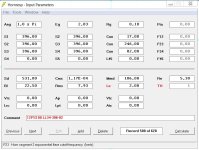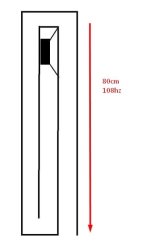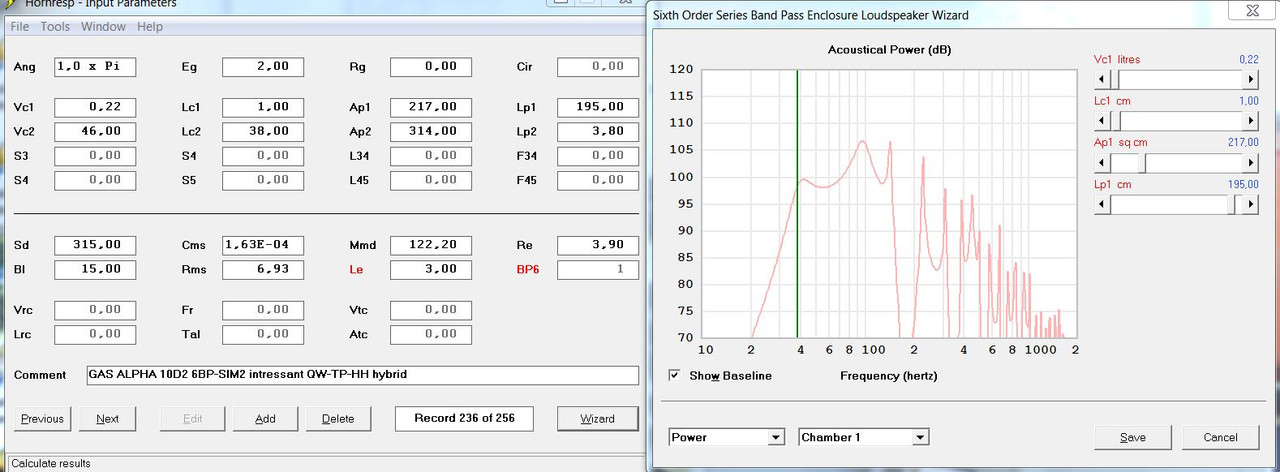Im interested in a bandwidth like this for near field subs. I want the non linear attack for movies. Would this be a large enclosure? Maybe with a 12 or 15?View attachment 1092089
If you trade the high efficiency of the ROAR for an extended bandwidth, but you stick with the QW based series 8th order BP, you end up with a strange looking simulated beast. It does need lots of DSP and some careful use of damping to tame the response to something suitable for indoor use.
View attachment 1092093
TP12LL34
I built a 12 inch version of this in the thread above.
There is measurements and a lot of discussions of the pros and cons of this kind of design.
But massive amounts of positive acoustic feedback does sound "odd" to some people.
I built a 12 inch version of this in the thread above.
There is measurements and a lot of discussions of the pros and cons of this kind of design.
But massive amounts of positive acoustic feedback does sound "odd" to some people.
interesting, the added length/resonator sure seems to suck out the middle of the bandwidth ?
Attachments
Last edited:
im having trouble modeling the hroar. i prefer hroar's form factor over the tp12ll34 or roar. i have dayton 12lf at my disposal currently. when i try to model it for hroar it just becomes a bunch of spikes and no useable bandwidth. ive tried the bp6s and th w/ chamber methods but cant seem to work it out.TP12LL34
I built a 12 inch version of this in the thread above.
There is measurements and a lot of discussions of the pros and cons of this kind of design.
But massive amounts of positive acoustic feedback does sound "odd" to some people.
I'm on my phone. What happens when you change L23 to 304.80cm?
It's because with a 0.21 Qts it's a compression horn or high power midbass prosound driver that in theory 'wants' a vented 20*1247.8*0.21^303 = 17.15 L, 0.42*28*0.21^-0.96 = 52.6 Hz Fb.i have dayton 12lf at my disposal currently. when i try to model it for hroar it just becomes a bunch of spikes and no useable bandwidth. ive tried the bp6s and th w/ chamber methods but cant seem to work it out.
Since you add mass (long L34 acts as a passive radiator) and with the help of the massive positive acoustic feedback enhance the upper part of the passband, you effectivly strech out the usable passband. The dip in the response is an area where the driver gets somewhat unloaded from the resonators and I would guess that the acoustic feedback (resonator feeds back through the driver) gets out of phase enough to become negative feedback.interesting, the added length/resonator sure seems to suck out the middle of the bandwidth ?
these are the same parameters as the original post by circlomanen using the same gas driver. what am i doing wrong?

What was wrong, Looks like you fixed it?these are the same parameters as the original post by circlomanen using the same gas driver. what am i doing wrong?
View attachment 1376449
Maybe make your second resonator longer, so that huge peak blends a little bit smoother into the lower resonace?
You get a pipe that tunes to about 27 hz?I'm on my phone. What happens when you change L23 to 304.80cm?
No I just posted a quote from circlomanen for reference. Literally same driver same box. Inputs look identical to me but mine is sh*t lol.What was wrong, Looks like you fixed it?
Maybe make your second resonator longer, so that huge peak blends a little bit smoother into the lower resonace?
Try connecting a resonator 1/3 (harmonic) as long as the upstream section and it’s crazy ‘obnoxious’, like a paraflex .
I just wanted to see what the response looked like with a longer length.You get a pipe that tunes to about 27 hz?
The lowest note on an 88 key piano = 27.5hz.
What would this look like as a schematic? I don't see where you would add another resonator between the two... 3 resonators, I think this box would be cumbersome. Also, Why are you modeling these as helmholtz bp and not th?View attachment 712734
If you balance a ROAR with an added quarter wave front section between the driver and the front resonator then you can get a very wide usable bandwidth. I have no idea how it will sound in real life, but it does look nice in Hornresp.
It is basically an 8th order ROAR15.
Take your pick...no angles or positive angles.these are the same parameters as the original post by circlomanen using the same gas driver. what am i doing wrong?

BTW, I have 4 VD-8's for a future F150 build.
you will be stuck listening to this as motor/mechanical noises or spiders at xmax etc...... its weird!!
I think there’s more to it than that as well? Harmonic distortion from lower notes being played but exciting those other resonances?.? Things I don’t understand but can ‘hear’?
Last edited:
It looks like Hornresp has changed since the original screenshot was posted. If you switch the parameters for chamber 1 and chamber 2 it should give the same responsethese are the same parameters as the original post by circlomanen using the same gas driver. what am i doing wrong?
View attachment 1376449
- Home
- Loudspeakers
- Subwoofers
- ROAR with Helmholtz front resonator




